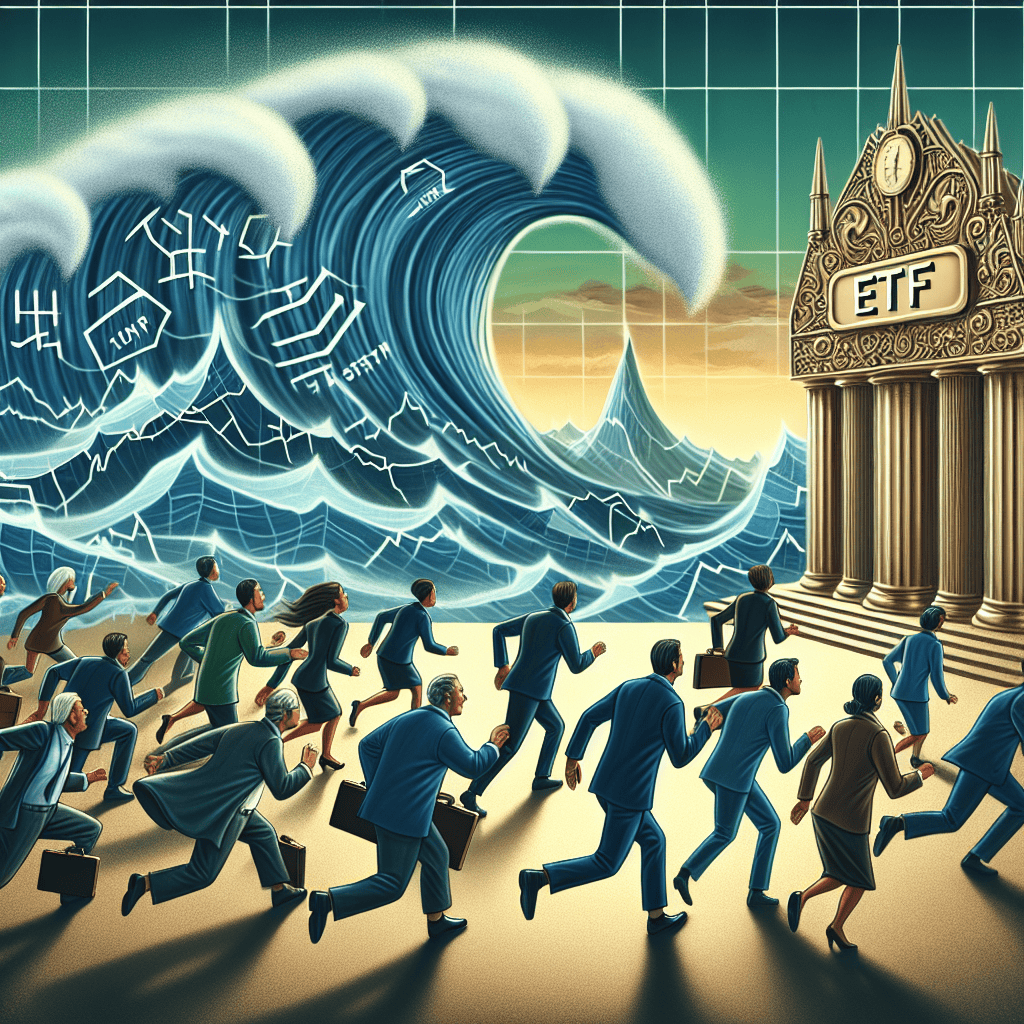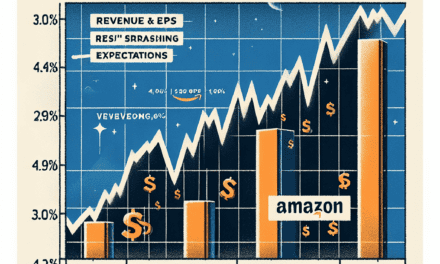“Shifting Tides: Investors Pivot from Thematic ETFs as Market Momentum Builds”
Introduction
In recent months, the stock market has experienced a significant surge, prompting a notable shift in investor behavior, particularly concerning thematic exchange-traded funds (ETFs). These investment vehicles, which focus on specific themes or sectors such as technology, clean energy, or biotechnology, have seen a decline in investor interest. As traditional market indices reach new highs, investors are increasingly opting for broader, more diversified investment strategies, moving away from the concentrated bets that thematic ETFs represent. This trend highlights a growing preference for stability and risk management in the face of market volatility, as investors seek to capitalize on the overall market upswing rather than betting on niche sectors. The abandonment of thematic ETFs underscores a strategic pivot among investors, reflecting a cautious optimism and a recalibration of risk in their portfolios.
Reasons Behind Investors Abandoning Thematic ETFs
In recent months, the financial landscape has witnessed a notable shift as investors increasingly turn away from thematic exchange-traded funds (ETFs) despite a robust stock market surge. This trend raises questions about the underlying reasons driving this change in investment strategy. Thematic ETFs, which focus on specific trends or sectors such as clean energy, technology, or healthcare innovation, have been popular in recent years due to their potential for high returns. However, several factors are contributing to their current decline in favor.
To begin with, the inherent volatility associated with thematic ETFs is a significant factor causing investors to reconsider their positions. These funds often concentrate on niche markets or emerging industries, which can be subject to rapid changes and uncertainties. As a result, they tend to exhibit higher volatility compared to more diversified investment options. In a market environment characterized by a strong upward trajectory, investors may prefer to minimize risk by reallocating their portfolios towards more stable and predictable assets.
Moreover, the recent stock market surge has been largely driven by traditional sectors such as finance, consumer goods, and industrials, which are not typically the focus of thematic ETFs. This shift in market dynamics has led investors to seek exposure to these outperforming sectors, thereby reducing their interest in thematic funds. The allure of capturing gains from well-established companies with proven track records is compelling, especially when these sectors are experiencing significant growth.
Additionally, the performance of thematic ETFs has been mixed, with some funds failing to deliver the expected returns. This inconsistency can be attributed to various factors, including regulatory changes, technological advancements, and shifts in consumer preferences, which can all impact the underlying industries of these funds. Consequently, investors may be disillusioned by the lack of consistent performance and opt for more reliable investment vehicles.
Furthermore, the cost structure of thematic ETFs can also play a role in their declining popularity. These funds often come with higher expense ratios compared to traditional ETFs, due to the specialized research and management required to maintain them. In a competitive market environment, investors are increasingly cost-conscious and may be unwilling to pay a premium for funds that do not consistently outperform their benchmarks.
In addition to these factors, the growing availability of alternative investment options has provided investors with more choices. The rise of actively managed ETFs and mutual funds, which offer professional management and the potential for outperformance, presents a compelling alternative to thematic ETFs. These options allow investors to benefit from expert insights and strategic asset allocation, which can be particularly appealing in a rapidly changing market landscape.
Lastly, the psychological aspect of investing cannot be overlooked. Thematic ETFs often attract investors with a strong belief in the underlying theme or trend. However, when these themes do not materialize as expected, it can lead to disappointment and a loss of confidence. As a result, investors may choose to abandon these funds in favor of more conventional investment strategies that align with their risk tolerance and financial goals.
In conclusion, the abandonment of thematic ETFs amid a stock market surge can be attributed to a combination of factors, including volatility, market dynamics, inconsistent performance, cost considerations, and the availability of alternative investment options. As investors navigate this evolving landscape, they are increasingly prioritizing stability, cost-efficiency, and reliable returns, leading to a shift away from thematic ETFs.
Impact of Stock Market Surge on Thematic ETFs
The recent surge in the stock market has led to a notable shift in investor behavior, particularly concerning thematic exchange-traded funds (ETFs). As the market experiences a robust upswing, investors are increasingly reevaluating their portfolios, leading to a discernible decline in interest in thematic ETFs. These investment vehicles, which focus on specific themes or sectors such as technology, clean energy, or biotechnology, have been popular in recent years due to their potential for high returns driven by targeted growth narratives. However, the current market dynamics are prompting investors to reconsider their strategies.
One of the primary reasons for this shift is the broader market’s performance, which has been characterized by a strong rally across various sectors. As major indices reach new highs, investors are finding attractive opportunities in more traditional, diversified investments. This trend is drawing capital away from thematic ETFs, which are often perceived as higher-risk due to their concentrated exposure to specific sectors. In times of market uncertainty or volatility, investors tend to gravitate towards more stable and diversified options, seeking to mitigate risk while still capitalizing on the overall market growth.
Moreover, the recent stock market surge has been fueled by a combination of factors, including strong corporate earnings, economic recovery, and accommodative monetary policies. These elements have contributed to a favorable environment for equities, encouraging investors to allocate funds towards broader market indices and diversified funds that can capture the general upward momentum. In contrast, thematic ETFs, which rely heavily on the performance of specific sectors, may not benefit equally from these macroeconomic tailwinds, leading investors to question their potential for outperformance in the current climate.
Additionally, the rise in interest rates has played a role in this shift. As central banks signal tighter monetary policies to combat inflation, the cost of capital increases, impacting growth-oriented sectors that thematic ETFs often target. Higher interest rates can lead to a reevaluation of growth prospects, particularly for sectors like technology and renewable energy, which are sensitive to changes in borrowing costs. Consequently, investors may perceive thematic ETFs as less attractive compared to more traditional investments that are better positioned to weather interest rate fluctuations.
Furthermore, the recent market surge has prompted a reassessment of valuation metrics. As stock prices climb, concerns about overvaluation become more pronounced, especially for sectors that have experienced rapid growth in recent years. Thematic ETFs, which often include companies with high growth expectations, may face increased scrutiny regarding their valuation levels. Investors, wary of potential corrections, might opt to reduce exposure to these funds in favor of investments with more reasonable valuations.
In conclusion, the current stock market surge is having a significant impact on investor sentiment towards thematic ETFs. As the broader market continues to perform strongly, investors are increasingly drawn to diversified and traditional investment options that offer stability and the potential to capture overall market gains. Factors such as rising interest rates and valuation concerns further contribute to the waning interest in thematic ETFs. As a result, these funds are experiencing a decline in popularity, highlighting the dynamic nature of investor behavior in response to changing market conditions.
Comparing Thematic ETFs and Traditional ETFs in a Bull Market
In recent years, thematic exchange-traded funds (ETFs) have captured the imagination of investors by offering exposure to specific trends or sectors, such as clean energy, artificial intelligence, or blockchain technology. These investment vehicles have been particularly appealing during periods of market uncertainty, as they allow investors to align their portfolios with emerging themes that promise long-term growth. However, as the stock market experiences a robust surge, a noticeable shift is occurring: investors are increasingly abandoning thematic ETFs in favor of more traditional ETFs. This trend raises important questions about the comparative advantages and disadvantages of these two types of investment vehicles in a bull market.
To begin with, it is essential to understand the fundamental differences between thematic and traditional ETFs. Thematic ETFs are designed to capitalize on specific trends or sectors, often focusing on a narrow slice of the market. This focus can lead to higher volatility, as the performance of these funds is closely tied to the success or failure of the underlying theme. In contrast, traditional ETFs typically track broader market indices, such as the S&P 500 or the Dow Jones Industrial Average, offering investors diversified exposure to a wide range of sectors and industries. This diversification tends to result in lower volatility and more stable returns over time.
As the stock market surges, the appeal of traditional ETFs becomes more pronounced. In a bull market, broad-based indices often experience significant gains, driven by widespread investor optimism and economic growth. Traditional ETFs, by mirroring these indices, allow investors to capture these gains while benefiting from diversification, which mitigates the risk associated with investing in a single theme or sector. Consequently, investors seeking to maximize returns in a rising market may find traditional ETFs more attractive than their thematic counterparts.
Moreover, the performance of thematic ETFs can be highly dependent on the timing of market trends. While these funds can deliver impressive returns when their underlying themes are in favor, they can also suffer substantial losses if the market shifts its focus. In a bull market, where investor sentiment can change rapidly, the risk of being caught on the wrong side of a trend is heightened. This risk is less pronounced with traditional ETFs, which are less susceptible to the whims of market trends due to their diversified nature.
Additionally, the cost structure of thematic ETFs can be a deterrent for investors in a bull market. These funds often come with higher expense ratios compared to traditional ETFs, reflecting the specialized research and management required to maintain their focus on specific themes. In a rising market, where returns are generally strong across the board, investors may be less willing to pay a premium for thematic exposure when they can achieve similar or better results with lower-cost traditional ETFs.
In conclusion, while thematic ETFs offer the allure of targeted exposure to emerging trends, their appeal diminishes in a bull market characterized by broad-based gains and investor enthusiasm. The comparative stability, diversification, and cost-effectiveness of traditional ETFs make them a more attractive option for investors seeking to capitalize on a surging stock market. As such, the current shift away from thematic ETFs underscores the importance of aligning investment strategies with prevailing market conditions, ensuring that portfolios are positioned to maximize returns while managing risk effectively.
The Future of Thematic ETFs in a Volatile Market

Thematic exchange-traded funds (ETFs) have long been a popular choice for investors seeking to capitalize on specific trends or sectors, such as technology, clean energy, or healthcare innovations. These investment vehicles allow individuals to align their portfolios with their personal beliefs or predictions about future market directions. However, recent trends indicate a shift in investor sentiment, as many are now abandoning thematic ETFs in favor of more traditional investment strategies. This change comes amid a broader stock market surge, prompting questions about the future of thematic ETFs in an increasingly volatile market environment.
To understand this shift, it is essential to consider the factors driving the current stock market surge. A combination of robust corporate earnings, economic recovery post-pandemic, and accommodative monetary policies have contributed to a bullish market sentiment. As a result, investors are increasingly drawn to the stability and predictability of broad-market ETFs and index funds, which offer diversified exposure to the overall market. This preference for diversification over concentration in specific themes reflects a growing caution among investors who are wary of the inherent risks associated with thematic investing.
Moreover, the performance of thematic ETFs has been mixed, with some funds delivering impressive returns while others have struggled to keep pace with the broader market. This inconsistency can be attributed to the speculative nature of thematic investing, which often involves betting on emerging trends that may take years to materialize. Consequently, investors who are seeking immediate returns may find thematic ETFs less appealing, especially when compared to the more consistent performance of traditional investment vehicles.
In addition to performance concerns, the high fees associated with thematic ETFs have also contributed to their declining popularity. These funds often come with higher expense ratios compared to their broad-market counterparts, which can erode returns over time. As investors become more cost-conscious, they are increasingly opting for low-cost index funds that offer similar market exposure without the added expense.
Despite these challenges, it is important to recognize that thematic ETFs still hold potential for long-term growth, particularly for investors with a high-risk tolerance and a strong conviction in specific trends. Thematic investing allows for targeted exposure to sectors that may benefit from structural changes in the economy, such as the transition to renewable energy or advancements in artificial intelligence. For those willing to weather short-term volatility, thematic ETFs can offer significant upside potential.
Looking ahead, the future of thematic ETFs will likely depend on their ability to adapt to changing market conditions and investor preferences. Fund managers may need to refine their strategies, focusing on themes with clear growth trajectories and reducing fees to remain competitive. Additionally, increased transparency and education around the risks and rewards of thematic investing could help attract a new wave of investors who are interested in aligning their portfolios with their personal values and beliefs.
In conclusion, while thematic ETFs face challenges in the current market environment, they remain a viable option for certain investors. As the stock market continues to evolve, these funds will need to demonstrate their value proposition by delivering consistent returns and adapting to investor demands. By doing so, thematic ETFs can carve out a niche in the investment landscape, offering a unique opportunity for those willing to embrace the risks and rewards of thematic investing.
Strategies for Investors Shifting Away from Thematic ETFs
As the stock market experiences a robust surge, investors are increasingly reevaluating their strategies, particularly in relation to thematic exchange-traded funds (ETFs). Thematic ETFs, which focus on specific trends or sectors such as technology, clean energy, or biotechnology, have been popular for their targeted approach and potential for high returns. However, the recent market dynamics have prompted a shift in investor sentiment, leading many to abandon these niche investment vehicles in favor of more diversified options.
One of the primary reasons for this shift is the inherent volatility associated with thematic ETFs. While these funds can offer substantial gains when their underlying themes are in favor, they are equally susceptible to significant losses when market conditions change. The recent stock market surge, driven by a broad-based recovery across various sectors, has highlighted the risks of concentrating investments in narrow themes. Consequently, investors are increasingly seeking strategies that offer a more balanced risk-reward profile.
In light of these developments, diversification has emerged as a key strategy for investors moving away from thematic ETFs. By spreading investments across a wider array of asset classes and sectors, investors can mitigate the risks associated with market fluctuations. This approach not only provides a buffer against sector-specific downturns but also allows investors to capitalize on the overall market growth. Moreover, diversified portfolios are better positioned to weather economic uncertainties, making them an attractive option for risk-averse investors.
Another strategy gaining traction is the adoption of core-satellite investment models. This approach involves building a core portfolio of broad-market ETFs or index funds, which provide stable, long-term growth. Around this core, investors can add satellite investments, which may include select thematic ETFs or individual stocks, to capture additional returns from specific trends. This model allows investors to benefit from the growth potential of thematic investments while maintaining a solid foundation that reduces overall portfolio volatility.
Furthermore, investors are increasingly turning to actively managed funds as an alternative to thematic ETFs. Unlike passive thematic ETFs, which track specific indices, actively managed funds offer the expertise of professional fund managers who can adapt to changing market conditions. These managers have the flexibility to adjust their investment strategies in response to emerging trends, potentially enhancing returns while managing risks more effectively. As a result, actively managed funds are becoming a preferred choice for investors seeking a more dynamic approach to portfolio management.
In addition to these strategies, investors are also placing greater emphasis on fundamental analysis when selecting investments. By focusing on the financial health and growth prospects of individual companies, investors can make more informed decisions that align with their long-term objectives. This shift towards fundamental analysis reflects a broader trend of prioritizing quality over thematic appeal, as investors seek to build resilient portfolios that can withstand market volatility.
In conclusion, the recent stock market surge has prompted a reevaluation of investment strategies, leading many investors to abandon thematic ETFs in favor of more diversified and resilient approaches. By embracing diversification, core-satellite models, actively managed funds, and fundamental analysis, investors can better navigate the complexities of the current market environment. As they adapt to these changes, investors are positioning themselves to achieve sustainable growth while minimizing risks, ensuring their portfolios remain robust in the face of future market challenges.
Analyzing the Performance of Thematic ETFs During Market Surges
In recent years, thematic exchange-traded funds (ETFs) have captured the imagination of investors by offering exposure to specific trends or sectors, such as clean energy, artificial intelligence, or blockchain technology. These investment vehicles have been particularly appealing to those looking to capitalize on emerging themes that promise substantial growth potential. However, as the stock market experiences a significant surge, a noticeable shift in investor behavior has emerged, with many opting to abandon thematic ETFs in favor of more traditional investment strategies.
The allure of thematic ETFs lies in their ability to provide targeted exposure to high-growth areas, often driven by technological advancements or societal shifts. During periods of market uncertainty or stagnation, these ETFs can offer a compelling narrative, attracting investors eager to tap into the next big thing. However, when the broader market experiences a robust upswing, as it has recently, the dynamics change. Investors often reassess their portfolios, seeking to maximize returns by reallocating capital to more diversified or established assets that tend to perform well in a bull market.
One reason for this shift is the inherent volatility associated with thematic ETFs. While they can deliver impressive returns during favorable conditions for their specific themes, they are also susceptible to significant downturns if those themes fall out of favor or fail to meet growth expectations. In contrast, during a market surge, traditional ETFs or index funds that track broader market indices, such as the S&P 500, often provide more stable and consistent returns. This stability becomes particularly attractive to investors looking to capitalize on the overall market momentum without the added risk of concentrated thematic exposure.
Moreover, the recent stock market surge has been characterized by a broad-based rally, with gains spread across various sectors and industries. In such an environment, the diversified nature of traditional ETFs allows investors to benefit from the rising tide lifting all boats, rather than relying on the success of a single theme. This diversification not only mitigates risk but also enhances the potential for capturing gains across multiple sectors, making it a prudent choice for many investors.
Additionally, the performance of thematic ETFs during market surges can be hindered by their relatively high expense ratios compared to traditional ETFs. These costs can erode returns, particularly when the broader market is delivering strong performance. As investors become more cost-conscious, the appeal of lower-cost investment options becomes more pronounced, further driving the shift away from thematic ETFs.
Furthermore, the recent surge in the stock market has been fueled by a combination of factors, including economic recovery, fiscal stimulus, and accommodative monetary policies. These macroeconomic drivers have created a favorable environment for equities in general, reducing the need for investors to seek out niche opportunities to achieve substantial returns. As a result, the broad market appeal of traditional ETFs becomes more compelling, leading to a reallocation of assets away from thematic funds.
In conclusion, while thematic ETFs offer unique opportunities to invest in specific trends, their appeal diminishes during periods of strong market performance. The volatility, concentrated exposure, and higher costs associated with these funds make them less attractive compared to traditional ETFs that provide diversified exposure and stability. As the stock market continues to surge, investors are increasingly prioritizing broader market participation over niche thematic plays, resulting in a noticeable shift in investment strategies.
Lessons Learned from the Decline in Thematic ETF Popularity
In recent years, thematic exchange-traded funds (ETFs) have captured the imagination of investors, offering a way to capitalize on specific trends and sectors such as clean energy, artificial intelligence, and blockchain technology. These investment vehicles promised targeted exposure to high-growth areas, appealing to those eager to align their portfolios with emerging global narratives. However, as the stock market experiences a robust surge, a noticeable shift in investor sentiment has emerged, leading to a decline in the popularity of thematic ETFs. This trend offers several lessons for investors and market observers alike.
To begin with, the allure of thematic ETFs often lies in their ability to tap into the zeitgeist, providing a sense of participation in the next big thing. Yet, this very appeal can also be a double-edged sword. Thematic ETFs are inherently speculative, as they rely on the successful realization of specific themes that may take years to materialize. As the broader stock market rallies, investors are increasingly drawn to more traditional, diversified investment options that offer stability and consistent returns. This shift underscores the importance of balancing thematic investments with a diversified portfolio to mitigate risks associated with niche market segments.
Moreover, the decline in thematic ETF popularity highlights the critical role of timing in investment strategies. Many investors entered thematic ETFs at the height of their popularity, driven by fear of missing out on potential gains. However, as market conditions evolved, these investments often underperformed compared to broader indices. This serves as a reminder that while thematic ETFs can offer substantial returns, they are also subject to significant volatility. Investors must exercise caution and conduct thorough due diligence, considering both the long-term viability of the theme and the current market environment before committing capital.
In addition, the waning interest in thematic ETFs reflects a broader trend of investor preference for simplicity and transparency. Thematic ETFs can be complex, with underlying assets that may not be well understood by the average investor. As the stock market surges, there is a growing inclination towards straightforward investment vehicles that provide clear and comprehensible exposure to market movements. This shift suggests that fund managers and financial advisors should prioritize investor education, ensuring that clients fully grasp the intricacies and potential risks associated with thematic investments.
Furthermore, the current market dynamics emphasize the importance of adaptability in investment strategies. As economic conditions and market sentiments shift, so too must investment approaches. The decline in thematic ETF popularity serves as a case study in the necessity of flexibility, encouraging investors to remain vigilant and responsive to changing market landscapes. This adaptability not only helps in navigating periods of volatility but also in capitalizing on new opportunities as they arise.
In conclusion, the retreat from thematic ETFs amid a stock market surge offers valuable insights into investor behavior and market dynamics. It highlights the need for diversification, the importance of timing, the preference for simplicity, and the necessity of adaptability in investment strategies. As investors continue to navigate an ever-evolving financial landscape, these lessons serve as guiding principles, ensuring that investment decisions are informed, strategic, and aligned with both current market conditions and long-term financial goals.
Q&A
1. **What are thematic ETFs?**
Thematic ETFs are exchange-traded funds that focus on specific investment themes or trends, such as technology, clean energy, or healthcare innovation.
2. **Why are investors abandoning thematic ETFs?**
Investors are abandoning thematic ETFs due to a shift in market sentiment towards broader market indices that are performing well during a stock market surge, seeking more diversified and stable returns.
3. **How does a stock market surge affect thematic ETFs?**
A stock market surge often leads investors to favor traditional, broad-based indices over thematic ETFs, which may be perceived as riskier or more volatile.
4. **What are the risks associated with thematic ETFs?**
Thematic ETFs can be riskier due to their concentrated exposure to specific sectors or trends, which may not perform well if market conditions change or if the theme loses popularity.
5. **What alternatives are investors considering instead of thematic ETFs?**
Investors are considering alternatives such as broad-based index funds or ETFs, which offer more diversification and are perceived as safer during market upswings.
6. **How have thematic ETFs performed compared to the broader market?**
Thematic ETFs have underperformed compared to the broader market during the recent surge, leading to decreased investor interest and outflows.
7. **What impact does investor abandonment have on thematic ETFs?**
Investor abandonment can lead to reduced liquidity, increased volatility, and potential closures of thematic ETFs if they fail to attract sufficient assets under management.
Conclusion
Investors have been moving away from thematic ETFs as the broader stock market experiences a surge. This shift suggests that investors are prioritizing broader market exposure over niche investment themes, possibly due to a perception of reduced risk and increased potential for returns in a rising market. Thematic ETFs, which focus on specific trends or sectors, may not be delivering the expected performance or diversification benefits in the current market environment. As a result, investors are reallocating their portfolios to take advantage of the overall market growth, indicating a preference for more traditional investment strategies during periods of market optimism.





